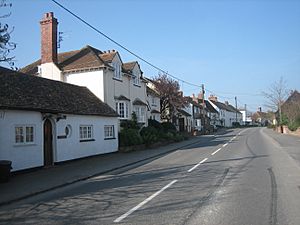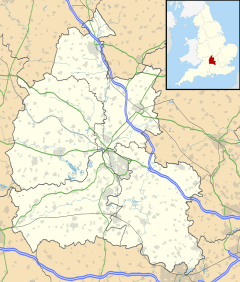Blewbury facts for kids
Quick facts for kids Blewbury |
|
|---|---|
 Blewbury |
|
| Area | 19.24 km2 (7.43 sq mi) |
| Population | 1,657 (2011 Census) |
| • Density | 86/km2 (220/sq mi) |
| OS grid reference | SU5385 |
| Civil parish |
|
| District | |
| Shire county | |
| Region | |
| Country | England |
| Sovereign state | United Kingdom |
| Post town | Didcot |
| Postcode district | OX11 |
| Dialling code | 01235 |
| Police | Thames Valley |
| Fire | Oxfordshire |
| Ambulance | South Central |
| EU Parliament | South East England |
| UK Parliament |
|
| Website | Blewbury |
Blewbury is a lovely village in Oxfordshire, England. It sits at the bottom of the Berkshire Downs, which are part of the North Wessex Downs. The village is about 4 miles (6.4 km) south of Didcot and 14 miles (22.5 km) south of Oxford.
Blewbury used to be part of Berkshire until 1974. In 2011, about 1,581 people lived here. Many small springs bubble up from the ground near the downs. Some of these springs feed a small lake called the Watercress Beds. Watercress used to be grown there. From these springs, small streams flow into the Mill Brook. This brook then carries the water to the river Thames at Wallingford. The A417 road runs through the southern part of the village. People from Blewbury are sometimes called "Blewbarians."
Contents
Ancient History of Blewbury
The southern part of Blewbury parish has many very old sites. These include areas of chalk downland. The Ridgeway, an ancient path, runs just south of the parish.
Blewburton Hill Fort
About half of the 360-foot (110 m) high Blewburton Hill is in the parish. At the top of this hill is an Iron Age hill fort. People might have lived there from about 400 BC to 100 BC.
Burial Mounds and Roman Sites
The highest point in the parish is Churn Hill, which is 520 feet (158 m) high. It is about 1.5 miles (2.4 km) southwest of the village. On its northwestern side, you can find two round burial mounds. The larger one is called Churn Knob. More round mounds are located further south.
During the Roman time, a special shrine or temple was built on Lowbury Hill, near the Ridgeway. Later, around the 7th century, an Anglo-Saxon burial mound was found near this Roman site. It contained a sword and a hanging bowl, which are now at The Oxfordshire Museum.
Blewbury's Old Manors
Historically, Blewbury was split into three main areas called manors. The Great Manor was owned by the King or Queen until the 1600s. The Prebendal Manor belonged to the Church. The third, Nottingham Fee, was bought by a local family, the Humfreys, around 1652. They kept some of this land, including the manor house called Hall Barn, for a long time.
St Michael's Church
The Church of England parish church of St Michael the Archangel is very old. Its earliest parts, like the main hall (nave) and a special area for the altar (sanctuary), were built in the 11th century. You can still see some of the original 11th-century windows.
Around 1190, the church was changed to have a cross shape. This meant new side sections (transepts) and a new altar area (chancel) were added. A tower was built where the arms of the cross met. Only the columns and ceiling of this central tower remain today.
Church Additions Over Time
In the 13th century, a south side aisle was added. In the 14th century, a north aisle and a special chapel for the Virgin Mary were built. The tall west tower was added in the 15th century. This might be when the central tower was taken down.
Also from the 15th century, you can see the choir stalls, a screen between the chancel and Lady chapel, and the baptismal font. Inside, there are several monumental brasses. These are metal plates with engraved pictures, mostly from the Middle Ages. One shows a priest named John Balam who died in 1496. Another shows a knight and his two wives from around 1500. There's even a brass from the 1800s, which is unusual, showing Faith in memory of a boy named John Macdonald who died at age 13 in 1841.
Around 1875, the north porch was rebuilt, and the roof of the nave was repaired. The church is a Grade I listed building, meaning it's a very important historic building.
Church Bells
The west tower has eight bells that can be rung. The oldest bell was made in 1586. Other bells were made in 1663, 1689, 1704, 1752, and 1825. The newest bells were added in 1906. St Michael's also has a small bell called a Sanctus bell, made in 1819.
Blewbury's Story Through Time
In 634 AD, a saint named Birinus came from Rome to teach Christianity in England. It is said that he preached to the local people from Churn Knob. He helped convert them, and he was allowed to start Dorchester Abbey. Today, people walk from Churn Knob to Dorchester every year to remember this event.
Early Records and Civil War
Blewbury is called "this venerable village" in its old Saxon records. We learn more about it from the Domesday Book of 1086. Back then, about 400 people lived there, and there were four water mills. Two of these mills are still here today.
During the English Civil War in the 1600s, Blewbury was caught between the King's forces and the Parliament's army. One day in 1644, after a battle, a group of King's soldiers arrived at Hall Barn and asked for lunch. After they left, a group of Parliament's soldiers arrived and asked for the same!
Farming and Changes
The land around Blewbury used to be farmed in large open fields. Tracks leading up to the downs were worn deep into the chalk by many animals. One of these tracks is still called Cow Lane. A chalk pit above the village was used to dig out chalk stone. You can still see this stone in local houses and walls.
In 1805, a law was passed to divide up the open fields into smaller, private plots. This law recorded many details about the parish at that time.
Modern Blewbury
The Didcot, Newbury and Southampton Railway line was built near the village in 1882. The closest station was called Upton and Blewbury, but it was actually 2 miles (3.2 km) away in Upton. The railway line closed in 1964.
Around the late 1800s, the open areas of the downs were used for military training each summer. Local farmers would provide food for the soldiers. A firing range was also used here until the 1970s.
Since the 1950s, Blewbury has become a popular place for people who work in the area or even in London. Old cottages have been fixed up and made bigger. New housing areas have also been built. Until about 1970, several stables for racehorses were in the village. One is still open today, and you can still see racehorse training tracks on the Downs south of Blewbury.
Historic Buildings in Blewbury
Blewbury has many old buildings made with timber frames. There is a special type of cottage called a cruck cottage on South Street. Hall Barn might have been built around 1660.
School and Almshouses
William Malthus, a merchant from London, left land to pay for a school in Blewbury. The school building, built in 1709, is near St Michael's church. It has a style called Queen Anne style.
Also near the church are two almshouses. These were homes for older people. One was built in 1738 for the oldest man in the village. The second was added 100 years later in 1838.
Other Interesting Buildings
Blewbury Mill, near East Hagbourne, is said to be where blotting paper was accidentally invented! Turnpike House in the village was a toll house. It collected money from people using the road between Wantage and Streatley.
Getting Around Blewbury
Thames Travel bus route 94 serves Blewbury from Monday to Friday. It connects the village to Didcot town and to Didcot Parkway railway station. Buses usually run once an hour, with more frequent service during busy evening times. There is no bus service on Saturdays or Sundays.
Famous People from Blewbury
In the 20th century, many famous artists and writers came to live in Blewbury. Some of the writers included Elizabeth Ferrars, Dick Francis (who lived there from 1954 to 1980), Kenneth Grahame (who wrote The Wind in the Willows), Marguerite Steen, GB Stern, Barbara Euphan Todd, and Ben Fergusson.
Artists who lived here included William Nicholson, who was the father of the famous abstract painter Ben Nicholson. Susan Beatrice "Twissie" Pearse, who illustrated children's books, also lived here. H Davis Richter, known for his interior paintings, and Eli Marsden Wilson were also residents. Even today, professional artists like Roy East and Ron Freeborn help guide local amateur artists. The village used to have an art gallery just for local artists' work.
Performing Arts in Blewbury
Every couple of years, Blewbury holds a festival. It features shows, dances, and exhibitions in many of the old houses. There's also a special walk along the Millbrook stream as it flows through private gardens.
The village has a strong tradition of theatre. There's an outdoor theatre at Orchard Dene house that can hold 250 people. Plays are performed there every summer. Local amateur actors and crew work with professional directors for these shows. Other theatre events also happen in the Village Hall.
Since 1978, about every five years, the village has asked a composer to write a new opera for amateur performers. These operas are performed in St Michael's church. Earlier operas even got attention from the media, including a TV film about The Snow Queen in 1982.
More recently, in April 2009, there was a new production of Benjamin Britten's Noye's Fludde. Around 2012, there were plans to perform the first opera ever created for Blewbury, Sir Gawain and the Green Knight. Its composer, Richard Blackford, now lives in the village.
Gallery
See also
 In Spanish: Blewbury para niños
In Spanish: Blewbury para niños











